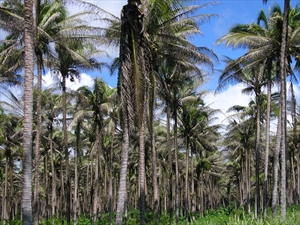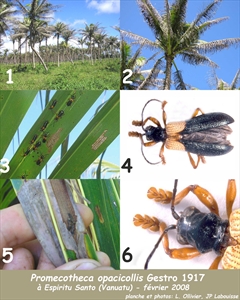Coconut leafminer, coconut leaf hispid
Pacific Pests, Pathogens, Weeds & Pesticides - Online edition
Pacific Pests, Pathogens, Weeds & Pesticides
Coconut leafminer (060)
Promecotheca species. Several species are recorded from Oceania. Promecotheca caerulipennis has a wide distribution among Pacific island countries. Promecotheca opacicollis has been identified as the species in Solomon Islands.
Promecotheca species are native to Indonesia, Philippines and Oceania. Promecotheca caerulipennis, the Fiji coconut hispid, is recorded from American Samoa, Federated States of Micronesia, Fiji, French Polynesia, Papua New Guinea, Samoa, Solomon Islands, Tonga, and Wallis & Futuna. Promecotheca opacicollis is recorded from Solomon Islands (Temotu Province), and Vanuatu. (The photos are from an outbreak in Vanuatu). CABI records Promecotheca papuana in Papua New Guinea and Solomon Islands.
Coconuts are the most important crop attacked, but the beetle also infests betel nut, sago palm, and a number of ornamental and wild palms. It is not a pest of oil palm.
The adults feed on the lower surface of the furthest third to a half of the leaflets, leaving narrow furrows (Photo 1); the larvae mine the leaflets, leaving large areas of damage (Photo 2). The youngest three to four leaves are first attacked.
Eggs, about 1.5 mm long, are laid on the underside of the leaflets of young fronds, either singly or 2-3 together - depending on the species - and covered with digested leaf fragments cemented together. The larvae hatch after 2-3 weeks (depending on the temperature), and penetrate the leaflets and form a mine parallel to the midrib. More than one larva can be present in each mine. The larvae moult 2-3 times and, as they grow, the mine enlarges in width from 1 to 5 mm. The mines are 80 to 400 mm long, depending on the species and the number of larvae in the mine. The larval stage is up to 40 days; that also depends on the species. The pupal stage occurs in the mine, and lasts about 12 days.
After emergence, males and females fly to younger leaflets on the same palm or to a young leaf of a palm nearby, grouping together on the underside of the fronds. The beetles are not strong fliers; but they prefer the tallest trees, especially ones in sunlight. The adult is about 1 cm long. Colours vary, but they are often colourful (Photo 3). One species from the Santa Cruz group, Solomon Islands, has a black head with wings of orange nearest the front and brilliant bluish purple to metallic green behind. About 2 weeks after emergence, they mate. The adults live for about 4 weeks.
In general, the beetles are more damaging to mature palms, 25 m or more in height, although seedlings may become infested. Occasionally, the green tissue on all leaflets is destroyed and, consequently, young nuts fall, yield is severely reduced, flower production ceases, and palms may die. Entire coconut plantations turn brown (Photos 4&5). Severe outbreaks set back nut production for at least 2 years. Such events are rare, however.
Outbreaks appear to be cyclical, every 10-15 years or so, and may be brought about by droughts. If this is the case, more frequent outbreaks of Promecotheca can be expected in future, as El Niño events intensify due to climate change. A poster of the coconut leafminer has been published (Photo 6).
On mature coconuts, look for signs of adult feeding on the lower parts of young fronds; the adults eat the lower epidermis making long grooves into the leaf, parallel to the veins. Hold the leaflets to the light to see these grooves as fine white lines (Photo 1). The leaflets become brown, then grey, almost white, and the tips shrivel and curl under. Look for the beetles during the day, 7-9 mm long, and brightly coloured. Look for signs of the larvae in the upper part of the leaflet. The older larvae should be visible at the end of the mines, which are straight, parallel, and similar in shape, when the leaflet is held to the light.
NATURAL ENEMIES
Promecotheca is under natural control throughout the Pacific island countries and only rarely do outbreaks occur. Several parasitoids, mostly minute wasps, that parasitise eggs and larvae, and parasitic fungi, have been reported. Pediobius parvulus (chalcid wasp) was introduced into Fiji from Java in 1933 and released on Vanua Balavu in the Lau group1. It was also released into Vanuatu. More recently (2010) it was recorded in eastern Solomon Islands from Promecotheca opacicollis, possibly an introduction from Vanuatu.
The ant, Oecophylla smaragdina, was found to be of the greatest importance in controlling Promecotheca papuana in Papua New Guinea, which also occurs in Solomon Islands (although attempts to establish it in Tikopia against Promecotheca opacicollis apparently failed). And the ants, Pheidole and Technomyrmex, are also known to attack egg masses.
CULTURAL CONTROL
Two cultural practices have been suggested. Whether these are useful is unclear, as they may be impractical, and the potential effects on any parasitoids present is unclear:
- Hand pick Promecotheca eggs and adults on seedlings in nurseries, and young palms in the field.
- Prune and burn infested fronds.
CHEMICAL CONTROL
The use of insecticides to control this insect is not recommended. Not only is it difficult to spray mature coconuts, and probably uneconomic to do so, but it will harm the parasitoids and delay the re-establishment of natural control. If sprays are needed in the nursery, do the following:
- Use plant-derived products, such as derris, pyrethrum or chilli (with the addition of soap). (See Fact Sheet no. 56)
- Alternatively, synthetic pyrethroids are likely to be effective, but will also kill natural enemies.
--------------------
Note, derris (Derris species) contains rotenone, an insecticide, often used as a fish poison; it should be used with caution. The commercial derris insecticide is made from Derris elliptica.
____________________
When using a pesticide, always wear protective clothing and follow the instructions on the product label, such as dosage, timing of application, and pre-harvest interval. Recommendations will vary with the crop and system of cultivation. Expert advice on the most appropriate pesticides to use should always be sought from local agricultural authorities.
AUTHORS Helen Tsatsia & Grahame Jackson
1Information from Swaine G (1971) Agricultural Zoology in Fiji. Her Majesty's Stationery Office. London; and Howard FW et al. (2001) Insects on palms. CABI Publishing, UK; and from Atumurirava F et al. Coconut leaf miner technical versus social analysis survey report (21-25 June 2010). Lata, Temotu Province, Solomon Islands; CABI (2019) Promecotheca papuana. Crop Protection Compendium. (https://www.cabi.org/cpc/datasheet/44535). Photos 1&2,4-6 Jean-Pierre Labouisse, CIRAD, Montpellier, France. Photo 3 Henderson RC, Crosby TK (2012) Fiji Coconut Hispid (Promecotheca caerulipennis): PaDIL - (http://www.padil.gov.au).
Produced with support from the Australian Centre for International Agricultural Research under project PC/2010/090: Strengthening integrated crop management research in the Pacific Islands in support of sustainable intensification of high-value crop production, implemented by the University of Queensland and the Secretariat of the Pacific Community.









